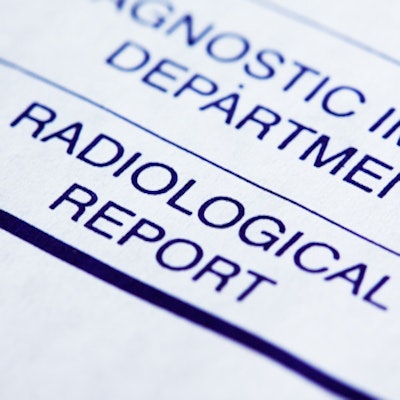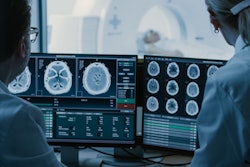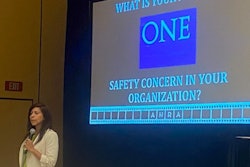
Mistakes happen in radiology -- just as in all professions. And while some safety incidents have significant consequences, others have no significance at all -- in fact, the majority of incidents are often dealt with locally and rather quickly.
 Dr. Louise Rainford, PhD, of University College Dublin, Ireland.
Dr. Louise Rainford, PhD, of University College Dublin, Ireland.But regardless of their potential impact, safety incidents in radiology should be reported, not only because there are legal requirements for open disclosure -- and the radiology's priority to ensure patients' well-being -- but also because reporting of even minor safety incidents gives administrators information to improve processes that can benefit both patients and staff.
Different countries and perhaps even different states and regions have their own regulations about open disclosure that must be followed. My goal here is not to define requirements for reporting safety incidents but rather to encourage and challenge radiology imaging directors to examine the culture and awareness around reporting within your departments.
Does every member of your staff know what types of incidents to report? Are the processes for reporting well known? How are radiographers treated when they admit to making a mistake? And are clinical staff treated the same across disciplines when they make mistakes?
Fostering an open, "no-blame" culture encourages more widespread reporting of safety incidents. This in turn gives administrators information to make improvements to processes or perhaps identify where additional training is needed -- possibly limiting incidents of "no harm" from becoming an incident that causes injury.
Types of safety incidents in radiology
In spite of a facility's best efforts, safety incidents happen in radiology, and they generally fall into one of three categories:
- Caused unintended or unanticipated injury or harm.
- Caused no actual harm or injury but a patient was placed at risk.
- Unintended or unanticipated injury or harm was "prevented either by timely intervention or chance," but risk was present if not prevented.
In other words: harm events, no harm events, and near miss events.
Minor incidents happen on a daily basis and are normally due to simple human errors that are often the result of tiredness or overwork. These minor incidents can be as simple as having a patient's incorrect date of birth or incorrect spelling of their name on their records. These errors might result in their imaging exam being lost.
Sometimes a physician inadvertently orders an incorrect exam; asking for imaging of a right leg when they actually mean the left, for example. Incorrect markers can result in a patient having to undergo a second exam and additional exposure to radiation.
Some safety incidents have nothing to do with radiation. A patient might slip and fall in the exam room; a radiographer might inadvertently touch or "catch" the patient with equipment. Also, aggressive and inappropriate behavior by patients is commonplace in accident and emergency departments.
Six steps for open disclosure
Not all incidents need to be reported; it is dependent on the regulations in your country. In Ireland, incidents of harm or suspected harm must always be disclosed. "Near misses" generally do not require disclosure to the patient. But again, if you are not capturing data on all safety incidents, you are missing an opportunity to make improvements in your radiology workflow.
Based on my research in this area, I offer these six recommendations to foster open disclosure.
- Acknowledge and discuss with your radiology staff that mistakes will happen. Encourage them to report even minor safety incidents -- including "no harm" and "no miss" events -- for the purpose of improving processes and preventing future incidents.
- Periodically review with radiographers the process for reporting safety incidents. Do they know who to contact? Do they know which forms to complete? Do they understand that as healthcare professionals, they are required also to report safety incidents that they observe?
- Review who owns the step of reporting an incident. A radiology department is dynamic and complex, and the responsibility for reporting an incident might vary. For example, teams and clinical leads change based on the procedure being performed. Sometimes the radiologist is in charge; at other times it might be the cardiologist. In some facilities, the radiographer is always considered "in charge of the room." Make sure your radiographers and other healthcare providers understand who should report an incident when it occurs -- and that they feel comfortable asking the question when they are not certain.
- Create and demonstrate a "no blame" culture. Published literature supports the fact that employees who feel they will be supported when making mistakes are more likely to report them and take responsibility for them. Without a supportive environment, mistakes might be hidden. There was a situation in the United Kingdom where a radiographer used the wrong exposure on a patient and hid the film rather than report it. A 2019 national Danish study of 208 MR professionals found that 25% of respondents had been in a safety incident that was not reported.
- Take a hard look at whether radiographers are given the same consideration and treatment when making mistakes as staff in other disciplines. I have witnessed radiographers being treated more harshly than physicians or radiologists when they made a mistake. Actively discuss within your clinical environment the fact that mistakes happen. Encourage all professions to be supportive of each other when safety incidents occur. Open disclosure requires all healthcare disciplines working together with the goal of improving patient safety and creating trust within your facility.
- Periodically review the safety incidents that have been reported and look for opportunities to improve your processes and gaps in training.
Open disclosure should be a top priority in radiology, and staff should feel supported when they admit to making a mistake.
This article was originally published on Carestream's Everything Rad blog: Open Disclosure in Radiology.
The comments and observations expressed do not necessarily reflect the opinions of Auntminnie.com or AuntMinnieEurope.com, nor should they be construed as an endorsement or admonishment of any particular vendor, analyst, industry consultant, or consulting group.



















